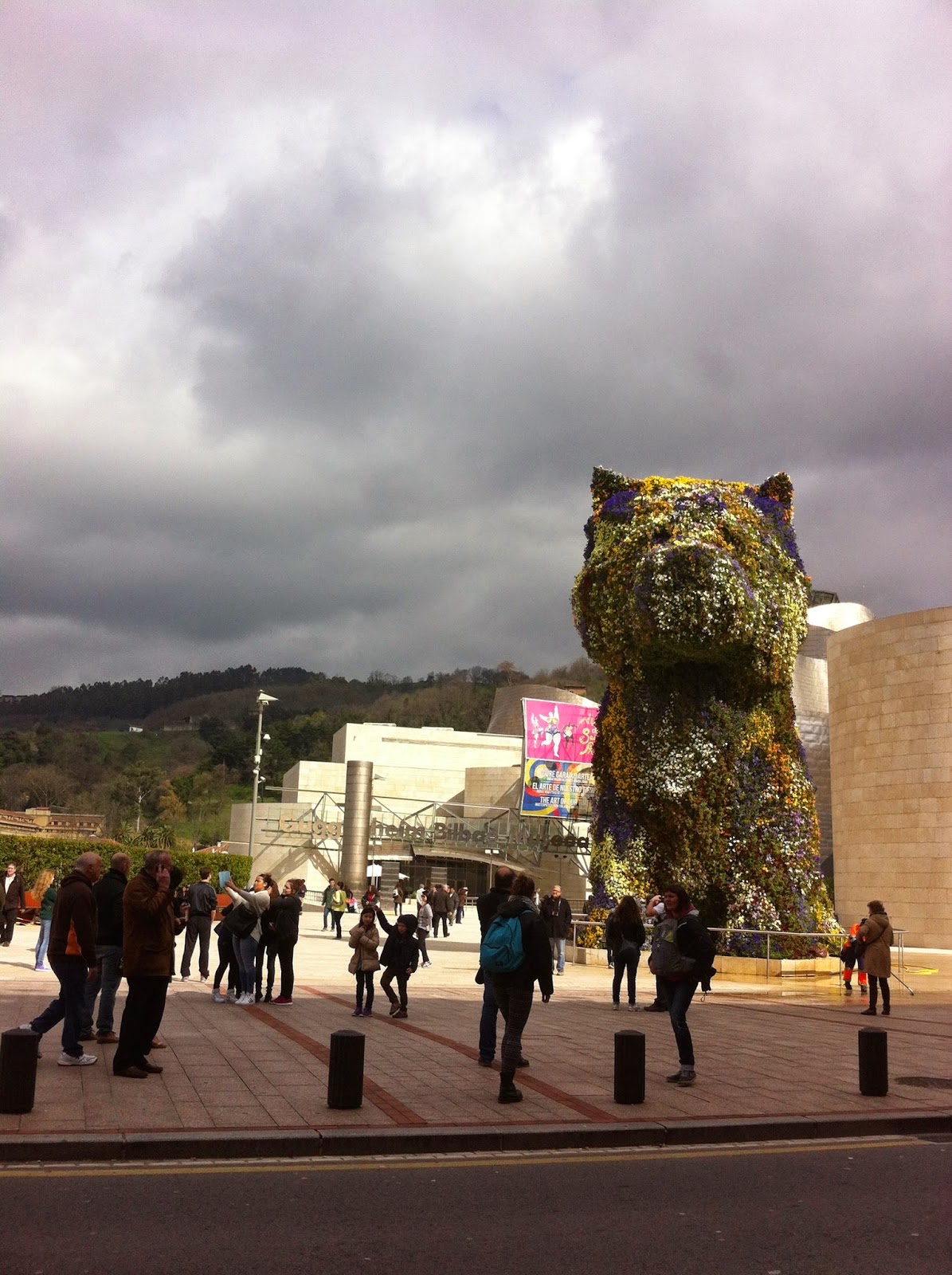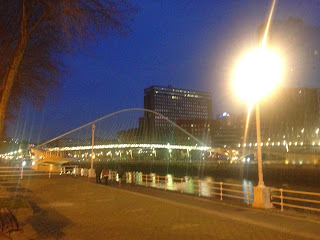 |
| A "Camino" sign in Segovia (Castilla y León) |
All along the path, pilgrims follow signs, which lead them through the Iberian Peninsula. These signs are all shaped like shells. Any visitor to Spain has probably seen one of these at some point, as they appear in almost every major city. The signs take on many different forms, some on the ground, some which appear like road signs, others are simply carved into stone. Whatever they look like, they're hard to miss. This shell has become one of the primary symbols of the Camino. The origins of this symbol have been disputed, but the most accepted myth dates back to the arrival of Saint James' body to Spain. The story goes that while his followers were transporting him to the peninsula, a storm hit the ship, sending the body overboard. Later, it is believed that it washed up on the shore of Galicia, covered in Scallop Shells. The shell itself stands for various things, holding its own version of symbolism for the pilgrim. For example, the grooves in the shell can be seen as the various routes, all leading to one point. Historically, it also served a purpose, as it was the perfect size and shape to be used to collect and drink water.
Another famous symbol that can be seen all throughout Spain which has its origins in Santiago is "la cruz de Santiago" or "the cross of St. James". It is shaped like a traditional cross, but with the end coming to a point, imitating the edge of a sword. The most common image also has flor-de-lys on the sides. This sign represents the Order of St. James. Founded originally in the 12th century, the initial purpose of this group was to protect the pilgrims on their way to Santiago de Compostela, and protect Christianity (as during this time, the peninsula was going through the "Reconquista", in which the Christian nations were waging a war against the Islamic occupation- lasting from 711-1492- of the souther regions).
 |
| It's hard to see, but the Cross is there on the outside of the balcony |
Whether you decide to travel to Santiago by way of the Camino, or more mornern forms of transportation, the city still seems to hold a sense of magic for all who visit. With the grey stone buildings, cobblestone roads, and narrow, winding streets, the city seems to be frozen in time. Walking through the old zone (Casco Historico) will be sure to transport visitors back in time.
The primary attraction of the city is the awe inspiring Cathedral. Containing elements of Romanesque, Gothic, and Baroque architecture, the original construction was started in 1075, with additions being done in the 16th, 17th, and 18th centuries. Easily one of the most impressive cathedrals in Spain, the outside is extremely ornate and simply breath-taking.
The inside of the Cathedral is as amazing as the outside. Upon entering through the main doors, visitors are greeted by the original facade, which was covered with the newer additions. It dates back to the 12th century, and has a Romanesque style. (Unfortunately I wasn't able to get a picture of it during my last visit, since it was being restored).
The altarpiece in the center of the church is one of the most exquisite I've seen. With ornate detail, covered in gold and jewels, it's almost impossible to take in all that it has to offer.
Visitors have the option of going both up into and down below the alter. Pilgrims, historically, and even nowadays, go up into the alter, where they are able to hug the saint. (In the past, the figure was covered in precious jewels, however, when people would hug him, they would bite them off with their teeth, leading to the decision to replace the real jewels with fakes). Below the alter there is a small window, which gives a glimpse of the box containing the supposed remains of Saint James.
 |
| Entrance to the crypt of Santiago |
 |
| In one of the chapels. Can you see the shell and the cross? |
For visitors that are feeling more adventurous, there is a roof-top tour. You have to go ahead of time to buy your tickets, and they have both Spanish and English tours available. Giving participants the "behind-the-scenes" view of the cathedral, you will be taken up the back stairs, around the balconies, and across the rooftop, which offers amazing views! It is by far one of the best parts of visiting Santiago!
The entire city of Santiago is spotted with various plazas and parks. The most famous of these is the Plaza del Obradoiro, from which you can see the main facade of the Cathedral. The word Obradoiro in Gallego (the language spoken in Galicia) is very similar to its Spanish equivalent "obrador". This means "workshop". This could be an indication of the previous use of the plaza, where workshops and stores were set up for the pilgrims as they arrived to Santiago. Now, the plaza is surrounded by the Cathedral on one side, the Hostal de los Reyes Católicos (which was a pilgrim hospital in its history, but is now a hotel- technically called a "Parador" which means it is owned by the Spanish government) the Colegio de San Jerome, and the Palacio de Raxio.
The true charm of this city is in discovering it for yourself. Getting lost in the Casco Viejo, finding small cafes and shops, and taking in the sights. The Rúa do Franco is the most famous street, as it is lined with bars, restaurants, and tiny shops. The streets running parallel to it are equally as impressive, and it would be very easy to spend an entire afternoon wandering from one restaurant to another, ordering a "ración" or "tapa", strolling in and out of shops, and letting yourself get lost in the medieval feel that this city boasts.
The most famous dish in Santiago is the "pulpo" or octopus. It's famous world-wide, and if you visit the northern region of Spain, it's a prerequisite to sample the amazing cuisine!
Speaking of food... While the entire city seems to be swarming with restaurant after restaurant and bar after bar, there is one place that is sure to please. Hidden away, O Filandon is a tapas bar located in the back of a wine shop. With a unique atmosphere and rustic vibe, visitors are warmed by a fireplace, while they enjoy a drink and some "embutido" (cured meats, like ham, chorizo, etc.) or a variety of other options! The walls are lined with napkins, which contain notes or messages from previous visitors, coming from all over the world to discover the magic of Santiago. The place is small, so its better to go later (around 3-4) as this is the end of the lunch rush.
As if the city didn't have enough charm already, one of the most quintessential aspects of the city are the various street performers. Located all around the old zone, musicians serenade the passerby with anything from guitar to gaita (a Galician bag-pipe).
 |
| A gaita performer (sorry the picture isn't very clear) |
 |
| I think this is a dijurido!! |
In short, Santiago is the city of magic. Pilgrims walking through the streets, locals bustling through their daily errands, all to the backdrop of Medieval Spain. Being that it is located in Galicia, it is expected that it will rain, but this in a way adds to the city's "encanto", making the stones glisten in the street lights.
I can say for sure that this city is not done with me, and I will be going back as soon as possible. Hopefully I'll do the Camino!













































